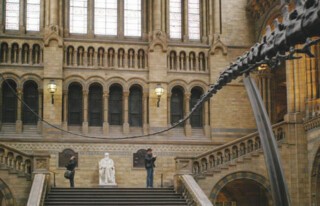The main hall of the Natural History Museum soars less dramatically than a Gothic nave, but otherwise isn’t unlike one. Light comes from high windows; there are upper galleries and chapel-like alcoves; and it is dominated by a statue in white marble of the local deity – Charles Darwin – who looks down at a huge dinosaur skeleton from the landing of the staircase that rises in a double flight at the north end. Darwin’s ideas are so central to biology that there is no wall of fossils, case of stuffed birds, diagram of genetic inheritance, animated dinosaur, laboratory or educational scheme in the museum that does not draw on, elaborate, or take its meaning from them. The whole building is a Darwin exhibition. That presents problems when you want to do something special to celebrate his 200th birthday.
Darwin Big Idea runs at the museum until 19 April. Given that the theory of evolution is constantly being underpinned by new discoveries and enlarged by new insights, defensive asides might seem unnecessary. To see video clips in the Natural History Museum of distinguished talking heads making the point that calling evolution a theory does not imply that it is just one explanation among equals, is a bit like finding a video booth in St Peter’s where you can listen to cardinals defending the virgin birth. It may have seemed necessary because this is a joint exhibition to which the American Museum of Natural History and other US institutions have contributed. The voices are from America, where creationism is a greater threat to science teaching. (Not that the British are all confirmed Darwinians. While polls suggest that just over half of the US population thinks evolution the best explanation for the development of life, more than 40 per cent in the UK think intelligent design should be taught in school science lessons – one can hope that that doesn’t mean they believe in it.) The exhibition’s hybrid origins may also explain why it was thought worthwhile to reconstruct Darwin’s study when the real thing is only a couple of hours away. (To be fair, you must wait until 13 February to visit it: English Heritage’s contribution to the anniversary is the refurbishment of Down House.) Meanwhile, the bits and pieces displayed here do make it a bit easier to imagine what it was like to be Charles Darwin: one of the few extant manuscript pages of the Origin of Species, for example, preserved because it was used as scrap paper by one of his children, who made a drawing of a house on the back.
His life, character and work are wonderful subjects. Print has advantages when it comes to telling stories: a string of very good biographies and Darwin’s own writings make the broken and abbreviated account that is all any exhibition can offer seem inadequate. Although Darwin wrote wonderfully about the years he spent circling the globe on the Beagle, he was sometimes at a loss for words. Natural history programmes on television have explored with greater and greater virtuosity the look of the kind of thing he found beyond description, and the familiarity with the extraordinary that television affords has perhaps dulled the sense of wonder that seeing such things once brought. The world can’t be quite as novel and strange to eco-tourists as it was to the first naturalist-explorers – Banks, Humboldt, Darwin, Wallace and the rest – but that is a small price to pay for the understanding new technology has brought.
What an exhibition can do that is not done better in any other medium is to show real things. The closest this one comes to giving an idea of what it was like to be Darwin the field naturalist is to be found in two glass cases: one is inhabited by a rather sinister grey spotted pudding of a horned frog, the other by a most elegant green iguana. A small sample, but seeing these live animals makes you realise that no image on screen or on paper can match them. There are, too, significant specimens from the vast amount of material Darwin sent back to England, in particular the sad little bodies of two mocking birds, similar but not identical – the kind of thing that made him more and more sure of the mutability of species. Stuffed birds – similar species of rheas, a goose made tame by isolation from predators, a flightless cormorant – tell the same story of isolation driving speciation. There are faded brown leaves on herbarium sheets and a number of demonstrations of the skeletal homologies that make it possible to match a finger bone to a bat’s wing bone or to find a rudimentary leg hiding among a snake’s multitude of ribs. There are fossils – or casts of fossils – he found in South America. A case of animal skeletons turns you into a comparative anatomist as your eye takes you from scapula to scapula and skull to skull, all different yet all built to the same pattern.
But it’s what might seem the dullest things in the exhibition – bits of paper with writing in brown ink or pencil; some of them letters, some notes or manuscripts – that take you to the heart of the matter. The little notebooks Darwin kept over the years are as near as you can get to hearing him think. In the ones that set out ideas on evolution, propositions based on evidence teased and tested in the mind are given their first physical form in a few scribbled words. Here the physical red-bound relic really is thrilling: guessing at the swiftness of the pen, following the layout of the page, takes you a little closer to the moment when memories and thoughts became ideas. But this exhibition, despite its title, can’t get around the fact that the ideas are essentially abstract. Following them into the 20th century wouldn’t have helped. The Mendelian genetics that eventually solved problems about the nature of inheritance that had puzzled Darwin are hard to illustrate, as are, for example, the statistics that make sense of altruism. The field geologists, comparative anatomists and taxonomists whose work Darwin built on, left more in the way of collections and illustrations – and this is why the museum’s collections, seen through Darwinian spectacles, should be read as part of the exhibition.
Send Letters To:
The Editor
London Review of Books,
28 Little Russell Street
London, WC1A 2HN
letters@lrb.co.uk
Please include name, address, and a telephone number.


